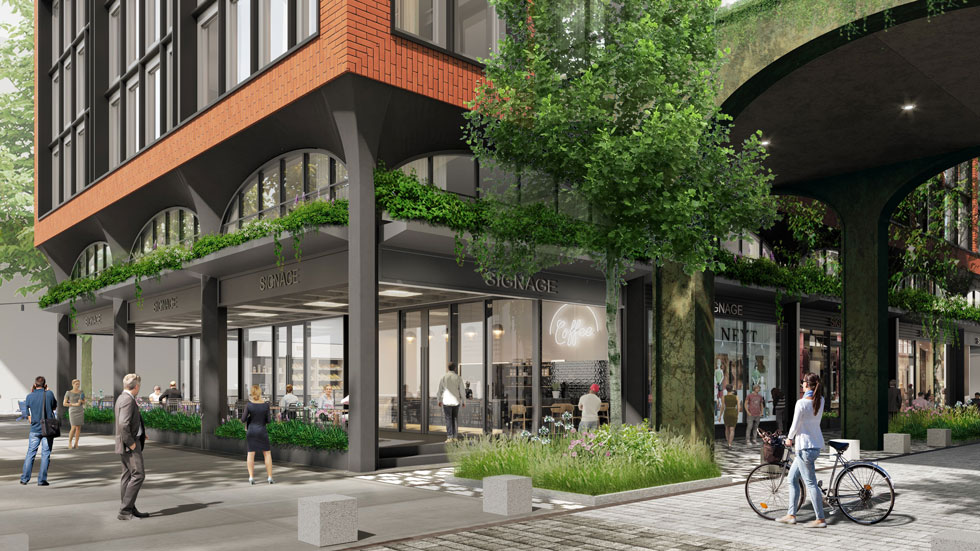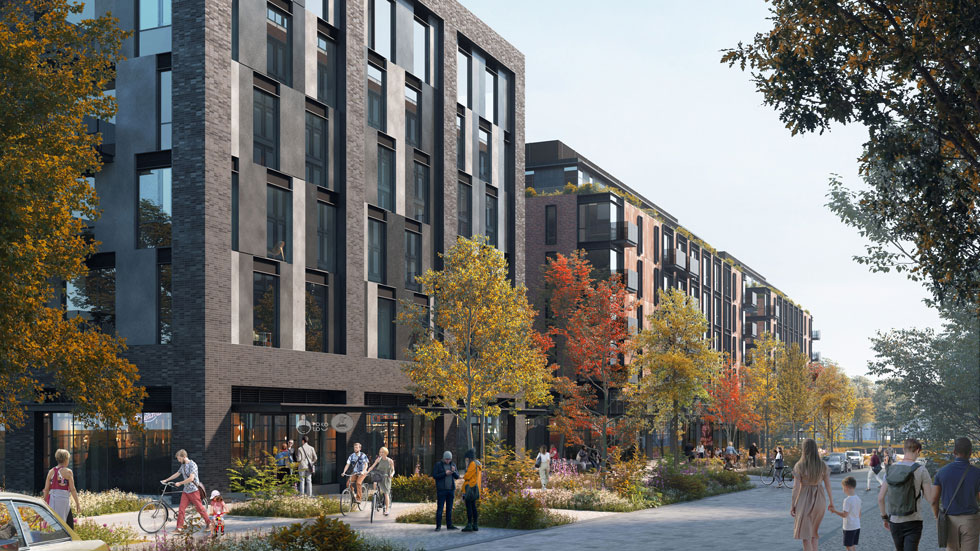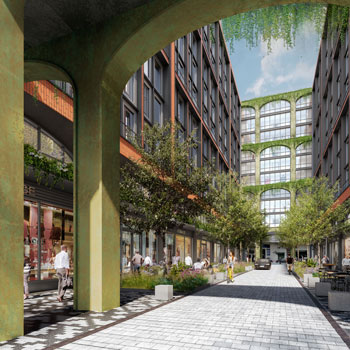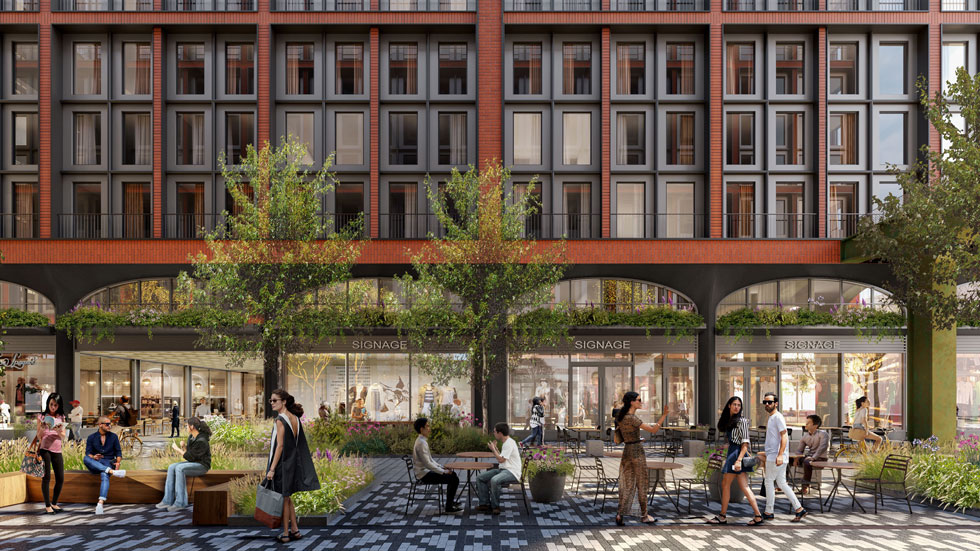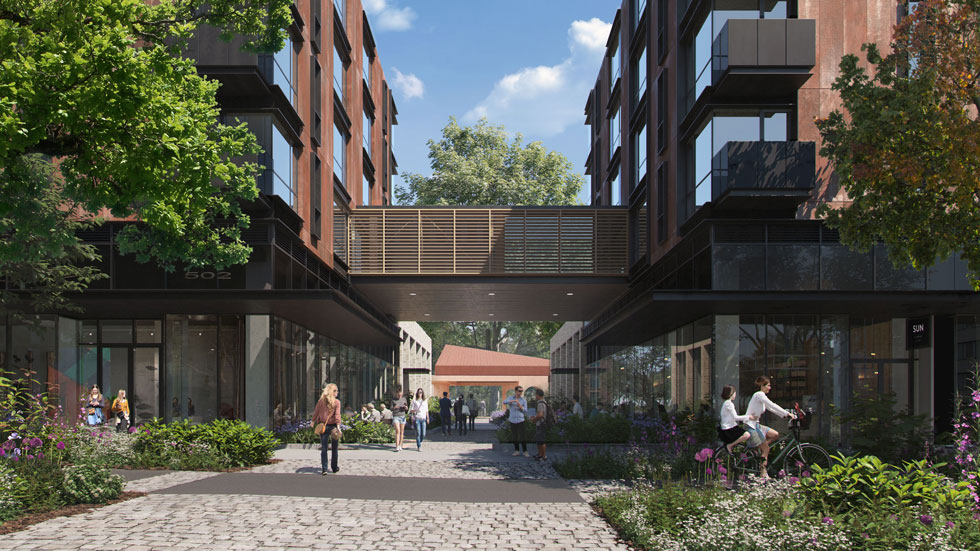An ongoing partnership between JBG SMITH (NYSE: JBGS) and Gallaudet University in Washington, D.C. aims to enhance and improve the unique campus environment of the nation’s leading educational institution for the deaf and hard of hearing, while also bringing it into closer alignment with its surrounding community.
In January 2022, Gallaudet, a private federally chartered research university, and JBG SMITH received final zoning approvals for the first phase of their collaborative Sixth Street Development project. The multi-phase project will develop a series of properties on the western edge of the university’s NoMa (North of Massachusetts Avenue) campus, creating mixed-use development and broadening Gallaudet’s interaction with the surrounding Washington, D.C. community.
Phase one includes three buildings totaling approximately 760,000 square feet of multifamily residential, 60,000 square feet of retail, and 17,000 square feet of university spaces.
“Gallaudet University has been around for 150 years, so we think in terms of centuries,” says Sam Swiller, director of strategic real estate planning, business development, and external relations for Gallaudet. “In the last two decades the university has become much more ambitious about how it wanted to face the world,” he says.
The arrival of the NoMa-Gallaudet metro station (thencalled New York Ave–Florida Ave– Gallaudet) in 2004 spurred a wave of new development and opportunity in the area. Historically, Gallaudet had been physically and in many ways socially—isolated from the surrounding area, though it had always played a vital role in the city’s community. The university decided that this was the right time to take agency over its land holdings and future development in order to realize its goal of increasing student interaction with the surrounding community, which includes the popular Union Market specialty food hall.
Beginning in 2014, it partnered with JBG SMITH. The Sixth Street Development includes four parcels of land and three phases, each with unique designs and approaches to achieving their joint goals.
“This project really allows Gallaudet to engage with this burgeoning Union Market neighborhood on its own terms, striking a balance with engagement, and preserving its unique campus environment,” says Robbie Saclarides, vice president of development at JBG SMITH.
JBG SMITH is also delivering approximately 150 affordable housing units across the project. The majority will be offered at the 50% MFI (median family income) level, the deepest level of affordability contemplated in Washington, D.C.’s Inclusionary Zoning Program.
Historic Roots
What would become Gallaudet University was established in 1864 when President Abraham Lincoln signed a bill into law after Congress authorized the institution to confer college degrees.
During its first commencement in 1869, diplomas were signed by President Ulysses S. Grant. Current presiding U.S. presidents continue the practice to this day. From its inception, Gallaudet has focused on advances in education of deaf and hard of hearing students and advocating for deaf rights worldwide.
Over the last 150 years, Gallaudet has evolved, becoming the leading institution for the education of deaf and hard of hearing, offering 40 majors for undergraduate degrees. The university also admits a small number of hearing, degree-seeking students. Graduate programs are open to deaf, hard of hearing, and hearing students. The university has roughly 22,000 alumni around the world.
“It’s a special place,” says Swiller, who identifies as hard of hearing but says he hadn’t learned American Sign Language (ASL) prior to first visiting the campus in 2009. “It was an eye-opening experience,” he recalls. When he first arrived at Gallaudet, Swiller taught classes, bringing his professional experience in real estate private equity to students before taking up his current role at the university.
Gallaudet employs ASL and written English for instruction. The campus represents the largest collection of ASL speakers in the world, so preserving and advancing its mission presented a unique set of challenges and opportunities for development.
Some of these include transitioning from a more pastoral campus to a more urban one, consolidating the university’s footprint to increase student interactions, orienting campus around a central heart, and building bridges between the campus and the larger community.
According to Swiller, the university faced a pivotal question: “How do we model a path for students to face the outside world and provide them with the best tools to meet the world on their terms?” To achieve its goals, the university created a real estate foundation to oversee its real estate activity and has conducted years of research to help answer this question.
Finding Partnership
The university also wanted to generate a stream of reliable cash to put to work in enhancing amenities for students, faculty, and staff, but selecting a developer presented its own risks.
“We were deeply concerned that whatever developer we brought on would be attentive to the needs of our school that focuses on the deaf and hard of hearing, which historically is a marginalized population,” Swiller says.
In 2012, Gallaudet launched an extensive request for proposal (RFP) process. Choosing from roughly 40 candidates, Gallaudet selected then-JBG Companies and finalized agreements in 2014. According to Swiller, JBG appealed to the university because it was a private developer with a great track record and financial capabilities, and it showed a deep understanding and respect for Gallaudet’s history and legacy.
JBG SMITH becoming a REIT in 2017 only added to their appeal, Swiller says, because they are long-term investors.
“As a REIT, we’re a long term holder which underpins our decision-making and I think Gallaudet is similarly a long term thinker, having been here since 1864,” Saclarides says. Sharing long-term visions helped when plans for Sixth Street were delayed for several years by a local lawsuit that was ultimately dismissed. The Sixth Street Development also fits well within JBG SMITH’s portfolio, which targets high-growth, transit-oriented markets.
“It’s been a lengthy, collaborative process that helped to establish the strong foundation of trust and understanding between the two parties,” Saclarides notes. “We’re working to get our first shovels in the ground, and we’ve been together every step of the way,” she adds.
The project has also involved collaboration with multiple public and private entities including district officials from the Department of Transportation, D.C. Water, D.C. Zoning Commission, as well as the community organizations such as the local Advisory Neighborhood Commission.
Gallaudet students and staff were also involved in identifying and selecting developers and throughout the process.
Unique Design
Design and architecture have provided another unique space for collaboration between JBG SMITH and Gallaudet.
The Sixth Street Project will employ DeafSpace Guidelines, more than 150 distinct architectural design elements developed by the DeafSpace Project, a collaboration between Gallaudet and architect Hansel Bauman. The guidelines address key touch points between deaf experiences and the built environment: space and proximity, sensory reach, mobility and proximity, light and color, and acoustics.
DeafSpace design also focuses on community building, visual language, and the promotion of personal safety and well-being. Built on long-held cultural traditions, Gallaudet research, and the latest architectural developments, DeafSpace accounts for challenges like poor lighting conditions—such as glare and backlighting—that interrupt visual communication.
“It’s about creating an environment that removes as much friction as possible for people that are visually communicative and those that are deaf-blind,” Swiller says. Basic examples include using techniques to minimize glare in rooms with direct sunlight, so it’s easier to see someone signing; knowing what design colors create the best contrast to the widest range of skin tones to allow for more visible signing, and creating circular seating areas to increase signing visibility and exchange. “DeafSpace design lends itself to good overall design,” Swiller says.
Gallaudet and JBG SMITH selected Seattle-based architects Olson Kundig for parcel two, which will abut the campus directly and the designed structures will gradually step down in scale as they approach the university to organically transition between environments. New York-based Morris Adjmi Architects was selected to design parcel three.
JBG SMITH and Gallaudet also partnered with landscape designers Future Green Studio on master planning for its open spaces and streetscapes to enhance comfort and safety for the deaf community.
“The public realm around our buildings will have the highest level of interaction with the deaf community and it was really important for us to deliver a design that supports ASL communication and the deaf experience,” Saclarides says. They’ve also enlisted deaf-owned, D.C.- based firm Copper & Water as consultants to peer review designs for Sixth Street Development.
Saclarides also notes the importance of creating designs with an understanding of edge conditions—zones of transition or the interface characteristics of a public space with its adjacent land uses and structures.
Their plans will deliver contextually-designed buildings that bridge the industrial warehouse buildings of the Union Market district and Gallaudet’s Victorian campus architecture with its bucolic central green, the latter designed by famed landscape architect Frederick Law Olmsted.
“It’s about working with the dichotomy of these contexts, historic in their own right, but coming from different roots,” Saclarides says, which aligns with the overarching principles for the Union Market district’s redevelopment. Striking a balance between old and new, stakeholders in Union Market district’s redevelopment plans have aimed to preserve the neighborhood character and traditional wholesale use of the area while fostering infusion of new mixed use.
Building Bridges
Neighborhood development through the Union Market district and Sixth Street Development provides new dining, recreation, and employment opportunities for students and neighbors.
Plans for phase two include 625,000 square feet of multifamily residential and 50,000 square feet of retail. By monetizing these sites via ground leases, the university gains an influx of funding to apply to this mission. Other tangible community benefits include infrastructure improvements, protected bike lanes that connect to the wider Washington, D.C. network, and the creation of a more pedestrian-friendly Sixth Street area.
For the Gallaudet community, these benefits are more than structural. “We’re focusing on bringing more of our students and administrative activity closer to the historic district of the campus, which aligns with university President Roberta Cordano’s vision for preserving and nurturing what’s called ASL vibrancy—the idea that the more people signing around each other, the more the usage of the language is enriched,” Swiller says.
Gallaudet hopes to share that vibrancy with the surrounding community, while also protecting it.
“One of our goals is to build bridges with the community,” Swiller says. “This is an opportunity for the university to reorient itself and become more outward focused and to create places where that can happen.”
Enter Creativity Way, the tentative name for the planned pedestrian, linear park that will form the university’s new “front porch.” When completed, Creativity Way will feature a cultural center and ‘knowledge studios’ to showcase university-wide research, scholarship, creative activity, and innovation. It will also provide an unparalleled opportunity for the broader Washington, D.C. community and beyond to learn from the deaf community and about deaf culture, and vice versa.
“It’s an opportunity for us to welcome the world and the community to our campus in a way that our students can feel safe and thrive,” Swiller says.
“This is one of the only places in the world that has dominant ASL interaction, so that needs to be respected,” says Saclarides.
“Creativity Way is striking a delicate balance of engaging with the community but also protecting their own very unique environment,” she says. JBG SMITH’s team aims for that exchange of knowledge and experience to go even further. The company employs interns from the Gallaudet community, helping to give students real-world experience while exposing existing JBG SMITH employees to the deaf community and a second language in ASL, hoping to inspire further opportunities in the broader community.
“It is very hard for deaf or hard of hearing individuals to get fair opportunities in their career and life,” Swiller says. “We’re hoping that this project will create a place where students become their own advocates and really move forward through the world empowered.”
